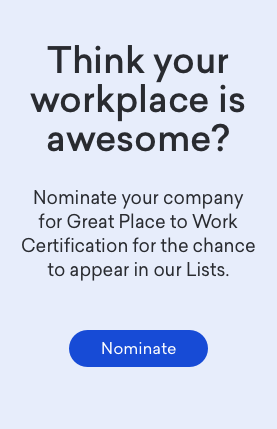Every generation seeks a company they can be proud of, a sense of community, and honest leaders.
The problem of having multiple generations in the workplace isn’t so complicated after all.
Our organization, consulting firm Great Place to Work, just produced lists of the Best Workplaces for Millennials, Gen X and Baby Boomers in partnership with Fortune. And our research, which involved surveying roughly 230,000 employees at some 620 organizations, challenges a lot of the typical talk about how different the generations are from one another—and what a headache it is to manage all of them at once.
For example, millennials are often portrayed as promiscuous job-hoppers, lacking the loyalty of their elders. But our data suggests that when millennials’ expectations of an excellent company culture are met, they are more than willing to stay. Millennials who feel they’re at a great workplace are an incredible 25X more likely to want to stay with their workplace for a long time.
And overall, we discovered that employees of all ages are looking for similar things in a great workplace: a company they can be proud of, a sense of community with their colleagues, and honest, ethical leaders.
“Executives and management have become very transparent with our current state and our future, as well as detailing areas of our finance, benefits, and how our company operates,” says one employee of Insomniac Games, a video game maker that earned a spot on the 100 Best Workplaces for Millennials list. “It’s great to have a very direct line of communication between employees and higher management.”
Pride, camaraderie and trust in leaders have remained bedrock features of a great workplace from the employee viewpoint since we began studying the topic more than 30 years ago. And when companies build a great culture for employees of all ages, they reap bottom-line business advantages in areas including productivity and talent retention. Employees’ willingness to be brand ambassadors for their organization—an important part of brand strategies given that the public trusts peers and employees over CEOs —also increases dramatically when staffers experience a great workplace. And this holds true no matter whether those employees are 20-, 40- or 60-somethings.

When it comes to combatting turnover, the benefit of a great workplace is even more striking. And again, the advantage can be seen across the generations.

To underscore the willingness of young employees to commit to the right company, consider a comment we heard from a Millennial employee from software company Salesforce—a Best Workplace for Millennials. “There are so many different career paths you can take at Salesforce that the journey does not have to end with one role, it is incredible,” the employee said. “I am not even 30 yet and I know that Salesforce is where I want to retire!”
“There’s more loyalty with Millennials than a lot of people think,” says Hannah Jones, a consultant at Great Place to Work.
Another discovery we made that runs counter to a stereotype concerns Gen X. This sandwich generation is sometimes labeled cynical. But our research found that Gen Xers are hungry for purpose—something more typically said of younger employees. Gen Xers are 7X more likely to look forward to coming to work when they feel their job is not “just a job” but has special meaning.
One of the ways Kimpton Hotels & Restaurants makes work meaningful for Gen Xers and other staffers is by showing love—and money—to the kids of employees. Kimpton, which made the lists of the Best Workplaces for both Gen Xers and millennials, gives all kids of hourly employees who earn a spot on their school honor roll a $25 gift certificate and a personal note of congratulations from CEO Mike DeFrino.
Employees of all ages care about the business ethics of their bosses. Houston-based homebuilder David Weekley Homes, a Best Workplace for each of the three generations, is among the companies that gets this. “Integrity is huge for David Weekley Homes,” one Baby Boomer employee of the firm told us. “We do a great job of NOT over-promising and then under-delivering. So many other large companies simply look at the bottom line. We are concerned with the long view.”
Another striking finding from our research on the Best Workplaces for different generations has to do with employee motivation. Companies spend much of their energy figuring out financial incentives to spur performance. But we found kindness in the workplace is a better bet.
“There’s what might be called an ‘ROI on Niceness,’” says Michael C. Bush, CEO of Great Place to Work. “Employees are more likely to give extra on the job when their workplaces are cooperative, caring, friendly and welcoming. To be sure, companies should not tolerate ‘cultures of comfort,’ where employees aren’t held to a high standard. But the ‘soft’ stuff of good relationships comes with the hard-nosed business advantage of employees working hard.”
Kindness is something people want to experience throughout their lifetime. So it’s not surprising that a friendly, caring, inclusive work environment prompts extra effort on the part of millennials, Gen Xers and boomers.
There’s yet another finding from our research that points to the generations having much in common when it comes to great workplaces. When we examined our Trust Index employee survey results for Gen X and baby boomer employees at the 100 Best Workplaces for Millennials, we discovered that all the generations were thriving in those companies. Gen X employees’ experiences were, on average, as positive as those of their Millennial colleagues. And baby boomers rated the workplace slightly better than their millennial co-workers.
That may have something to do with the way millennials have raised the bar for workplace cultures generally. This generation, in demanding more meaning, community, balance and transparency in their work lives, appears to be changing companies to the benefit of Gen Xers and baby boomers as well. “It might be that the things companies are doing to attract millennials are attractive to everyone,” Jones says. “There’s a dialog going on around this generation that didn’t go on before.”
That new dialog, though, is about age-old features of a great workplace. About a workplace where people can feel good about what they do, enjoy their colleagues and trust their leaders.
And in that sense, the anxiety about managing a multigenerational workplace is unnecessary. There may be three generations in organizations today. But the strategy for handling millennials, Gen Xers and baby boomers is clear: trust, pride and camaraderie will bring them together in a great, high-performing workplace.
- Also Read: The 100 Best Workplaces for Millennials
- Also Read: The 20 Best Workplaces for Gen X’ers
- Also Read: The 20 Best Workplaces for Baby Boomers














